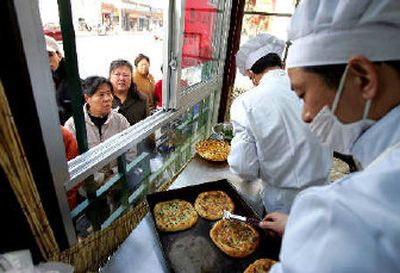Chinese growth understated

BEIJING — Walk into a bustling Beijing mall or pricey Shanghai restaurant, and official figures that say China’s annual economic output is just $1,000 per person seem much too low.
When Beijing releases a new survey of its economy next week, outsiders expect it to make a greater effort to measure such thriving service businesses, possibly revealing that China has been even more successful than reported over the past decade.
Economists say China’s already stunning figures that show growth at more than 9 percent this year understate output by up to 20 percent — a hidden $330 billion out of the reported $1.65 trillion in goods and services produced last year.
It isn’t clear by how much the government might raise its estimate of China’s economic output. But the results could have a far-reaching impact on economic and social policy, debates with Washington over the value of China’s currency and investment decisions.
“You could say China is actually 20 percent richer than anybody initially thought,” Qu Hongbin, an economist for financial services firm HSBC Corp. in Hong Kong, said Wednesday.
The key problem lies in China’s statistical system, a communist-era throwback that focuses on manufacturing and relies on businesses to have a full-time employee to report statistics, which mom-and-pop shops and other small, private firms rarely do.
The biggest weakness is in services, ranging from restaurants and Internet retailers to taxi drivers and barbershops, areas that represent China’s fastest-growing industries.
This year, economists say Beijing has made an effort to reflect their contribution by sending researchers to get data from restaurants, shops and other service industries.
The results are due to be released Tuesday by the National Bureau of Statistics.
Estimates by Chinese academics and private economists of how much they might raise figures for economic growth range widely, from almost nothing to a full 20 percent.
Chen Xingdong, an economist in Beijing for BNP Paribas Peregrine Securities, said he believes current statistics undercount China’s output by a minimum of 20 percent.
A woman who answered the phone Wednesday at the Statistics Bureau’s Census Center and would give only her surname, Deng, refused to give any details of next week’s report.
But when asked about suggestions that it might raise the figure on China’s economic output, or gross domestic product, by up to 20 percent, the woman said, “this figure is totally wrong.”
For years economists have said China’s figures understate the strength of its economy, because the low cost of goods and services adds considerable buying power to the Chinese currency, the yuan.
A large revision next week could push Beijing up the rankings of economies, from No. 7 to as high as No. 4, Chen said. That would put China behind only the United States, Japan and Germany and could provide fodder for trading partners who complain that the yuan is undervalued and contributes to China’s huge trade surplus.
America’s trade deficit with China surged to a new monthly record of $20.5 billion in October, the Commerce Department reported on Wednesday. Through October, the deficit with China is running at an annual rate of $200 billion. That surpasses last year’s imbalance of $162 billion, which had been the biggest U.S. deficit ever recorded with a single country.
A large revision also could alter industrial and social policy, changing the belief that China relies too heavily on manufacturing, said Qu. He said current figures show that services account for 30 percent of the economy, versus manufacturing’s 45 percent.
“This could easily turn the story upside down and say China’s service sector is a world competitor, and if anything there’s room for China to expand its industrial base,” he said.